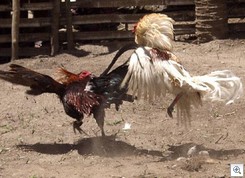 Cockfights are banned throughout most of the world, including Canada and the United States, with the exception of Oklahoma. No European, African, or continental Asian country allows the sport; the only Pacific jurisdictions that permit cockfighting are the Philippines and Guam. Most of the “action” is found in Latin America and the Caribbean, including Puerto Rico, Mexico, Panama, Honduras, the Dominican Republic, Aruba, Guadeloupe, Martinique, and Haiti. Although banned almost everywhere, the fights are also found in many clandestine locations throughout North America.
Cockfights are banned throughout most of the world, including Canada and the United States, with the exception of Oklahoma. No European, African, or continental Asian country allows the sport; the only Pacific jurisdictions that permit cockfighting are the Philippines and Guam. Most of the “action” is found in Latin America and the Caribbean, including Puerto Rico, Mexico, Panama, Honduras, the Dominican Republic, Aruba, Guadeloupe, Martinique, and Haiti. Although banned almost everywhere, the fights are also found in many clandestine locations throughout North America.
Cockfighting dates back to the ancient world. Greeks and Romans bred birds especially for fighting purposes. J. Philip Jones’s history of gaming, Gambling: Yesterday and Today, a Complete History (Jones 1973), tells of a Greek commander who was inspired by two fighting birds on his way to a victorious battle against the Persians in the fifth century b.c. In giving thanks for his triumph, he declared that there would be cockfighting everywhere in a celebration recognizing the victory (Jones 1973, 97). The activity spread throughout Europe.
At first the birds fought on tabletops, but later enclosed pens were used. The Romans brought fighting birds to England, and cockfighting developed into a popular activity there during the seventeenth century. In the American colonies, the cockfight was a regular side attraction at a horse race meeting. As birds are bred, they are closely watched for signs that they could be fighters. The training process is as elaborate as that used for racing horses or dogs. Each “cockmaster” directs the bird in rituals and practice fights using leather guards over their spurs. Before they are engaged in contests, they may be allowed to remove their spur covers and attack other chickens in order to keep their instincts intact. They are isolated so they can rest and fast before the match to ensure that they are “fresh and ready” for battle.
Betting at the cockfight is usually conducted privately on a one-on-one basis among the players. There are also bookies who will cover the action of many bettors. The heaviest betting is between the owners of the birds, with the loser losing not only money but also his prize fighter. The vicious nature of the fight to the death causes animal protective groups to vigorously oppose the sport. It was banned in England in 1834, and in most U.S. jurisdictions not long afterwards. Clifford Gertz offers a poignant description of the emotions of participation in the cockfight in his essay, “Deep Play: Notes on the Balinese Cockfight”.
|
|